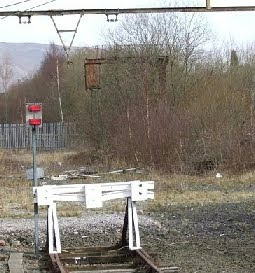The famous "Woodhead" route between Manchester and Sheffield was electrified in 1953. At the same time multi aspect colour light signalling was installed. This clip from a signalbox diagram for Hadfield shows a very distinctive bracket signal (circled in blue), so constructed to bridge the entrance to the sidings, already disused by the time this diagram was current. The line closed to passengers in 1970 ....
But as late as 1978, with trackwork rationalised, the long bracket signal remains. Freight traffic was withdrawn in 1981 and Hadfield became the joint terminus (with Glossop) of the local service from Manchester Piccadilly. Standing at the eastern end of Hadfield's one remaining platform, there is little left of the once busy passenger and freight route via Woodhead to Sheffield. But, what do we spy here ...
Buffer stop, warning light and undergrowth; but there; refusing to die and some 30 years after the line closed is THAT bracket signal.
And an extra note added in July 2011.
It's still there, fuzzily and at full magnification and almost engulfed with trees.
And an extra note added in July 2011.
It's still there, fuzzily and at full magnification and almost engulfed with trees.
Shouldn't someone have recycled it?












